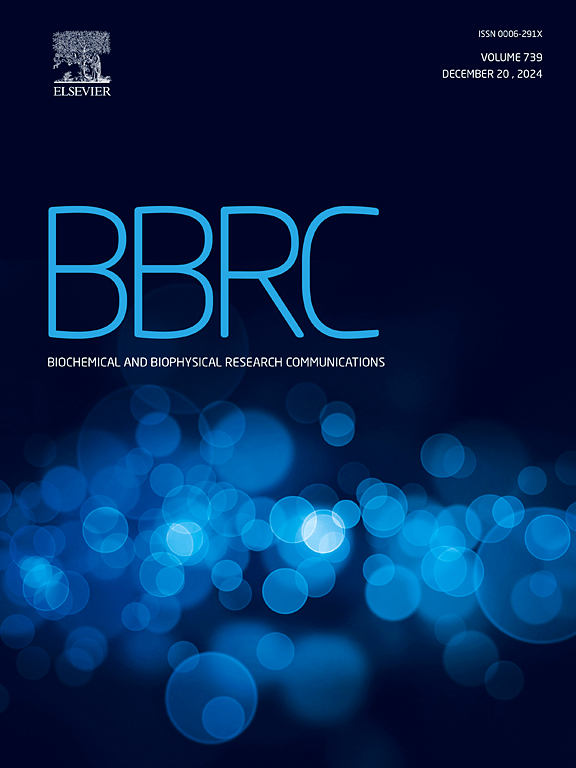Molecular mechanism of secretory protein EFNA1 in HNSCC and its value in early screening
IF 2.5
3区 生物学
Q3 BIOCHEMISTRY & MOLECULAR BIOLOGY
Biochemical and biophysical research communications
Pub Date : 2025-06-21
DOI:10.1016/j.bbrc.2025.152243
引用次数: 0
Abstract
Background
Head and neck squamous cell carcinomas (HNSCC) is an aggressive malignancy, necessitating early diagnostic biomarkers. This study explores EFNA1's role in HNSCC and its potential for early screening.
Methods
Data from TCGA, CCLE, and Depmap databases were analyzed. Serum samples from HNSCC patients and controls were tested using ELISA. Cell proliferation, apoptosis assays, and KEGG pathway analysis were conducted. Western blotting assessed EphA2pS898, EphA2, and EFNA1's impact on the AKT/ERK1/2 pathway.
Results
EFNA1 expression was significantly higher in HNSCC tissues compared to healthy tissues (P < 0.05). ROC analysis showed an AUC of 0.924 for EFNA1 in predicting HNSCC, indicating its diagnostic potential. Serum EFNA1 levels were elevated pre-surgery and decreased post-surgery (P < 0.05), correlating with poor prognosis (P = 0.021). EFNA1 knockdown in BICR78 and SNU46 cells induced apoptosis (P < 0.05). EFNA1 overexpression increased proliferation, which was reversed by EFNA1 antibody. EFNA1 downregulated AKT/ERK1/2 pathway activity, with its interference preventing full pathway activation.
Conclusion
EFNA1 is a promising biomarker for early HNSCC screening and a potential therapeutic target.
分泌蛋白EFNA1在鳞状细胞癌中的分子机制及其早期筛查价值
背景头颈部鳞状细胞癌(HNSCC)是一种侵袭性恶性肿瘤,需要早期诊断的生物标志物。本研究探讨了EFNA1在HNSCC中的作用及其早期筛查的潜力。方法对TCGA、CCLE和Depmap数据库数据进行分析。采用ELISA法检测HNSCC患者和对照组的血清样本。进行细胞增殖、凋亡和KEGG通路分析。Western blotting检测EphA2pS898、EphA2和EFNA1对AKT/ERK1/2通路的影响。结果fna1在HNSCC组织中的表达明显高于正常组织(P <;0.05)。ROC分析显示EFNA1预测HNSCC的AUC为0.924,提示其诊断潜力。术前血清EFNA1水平升高,术后降低(P <;0.05),与预后不良相关(P = 0.021)。EFNA1敲低在BICR78和SNU46细胞诱导凋亡中的作用(P <;0.05)。EFNA1过表达可促进细胞增殖,而EFNA1抗体可逆转细胞增殖。EFNA1下调AKT/ERK1/2通路活性,其干扰阻止了全通路的激活。结论efna1是一种有前景的HNSCC早期筛查生物标志物和潜在的治疗靶点。
本文章由计算机程序翻译,如有差异,请以英文原文为准。
求助全文
约1分钟内获得全文
求助全文
来源期刊
CiteScore
6.10
自引率
0.00%
发文量
1400
审稿时长
14 days
期刊介绍:
Biochemical and Biophysical Research Communications is the premier international journal devoted to the very rapid dissemination of timely and significant experimental results in diverse fields of biological research. The development of the "Breakthroughs and Views" section brings the minireview format to the journal, and issues often contain collections of special interest manuscripts. BBRC is published weekly (52 issues/year).Research Areas now include: Biochemistry; biophysics; cell biology; developmental biology; immunology
; molecular biology; neurobiology; plant biology and proteomics

 求助内容:
求助内容: 应助结果提醒方式:
应助结果提醒方式:


